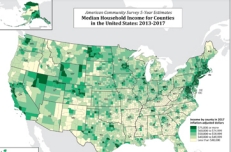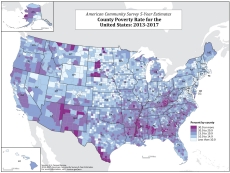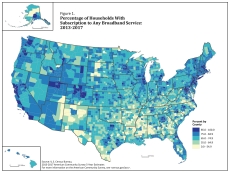Five-Year Trends Available for Median Household Income, Poverty Rates and Computer and Internet Use
For Immediate Release: Thursday, December 06, 2018
Five-Year Trends Available for Median Household Income, Poverty Rates and Computer and Internet Use
American Community Survey Releases New Data for All Communities Nationwide
DEC. 6, 2018 — Today, the U.S. Census Bureau announced the release of the 2013-2017 American Community Survey (ACS) five-year estimates, which features more than 40 social, economic, housing and demographic topics, including homeownership rates and costs, health insurance, and educational attainment. The ACS five-year data release produces statistics for all of the nation’s 3,142 counties. It is the only full data set available for the 2,316 counties with populations too small to produce a complete set of single-year ACS estimates.
“The American Community Survey provides detailed profiles of communities nationwide. The ACS is an ongoing survey that offers vital information on a yearly basis about our nation and its people,” said Victoria Velkoff, Associate Director for Demographic Programs. “It’s our country’s largest source of small area estimates for socio-economic and demographic characteristics. Information from the survey generates data that help determine how more than $675 billion in federal and state funds are distributed each year.”
Some highlights from the report include that, when comparing the 2013-2017 period to the 2008-2012 period, median household income increased in 16.6 percent of all counties (521 counties) between the 2008-2012 period and the 2013-2017 period while poverty declined in 14 percent of all counties 441 counties). Alternatively, when comparing the same time periods, median household income declined in 222 counties (7.1 percent) and poverty rates increased in 264 counties (8.4 percent).
DATA HIGHLIGHTS
The following highlights are from the 2013-2017 ACS five-year release.
Income
- Of the 3,142 counties in the United States, median household income declined in 222 counties (7.1 percent), while median household income increased in 521 counties (16.6 percent) when comparing 2013-2017 five-year estimates with 2008-2012 estimates.
- For the 2013 to 2017 period, among the geographic areas with 10,000 people or more, the locations with the highest and lowest median household incomes were:
- By county and county equivalent:
- Loudoun County, Va.; Fairfax County, Va.; Howard County, Md.; Falls Church City, Va.; and Arlington County, Va., were among the highest counties by median household income.
- McCreary County, Ky.; Holmes County, Miss.; Sumter County, Ala.; Bell County, Ky.; and Harlan County, Ky., were among the lowest.
- By metropolitan statistical area:
- San Jose-Sunnyvale-Santa Clara, Calif.; Washington-Arlington-Alexandria, D.C.-Va.-Md.-W.V.; San Francisco-Oakland-Hayward, Calif.; Bridgeport-Stamford-Norwalk, Conn.; and California-Lexington Park, Md., were among the highest metropolitan statistical areas by median household income.
- Brownsville-Harlingen, Texas; Sebring, Fla.; McAllen-Edinburg-Mission, Texas; Valdosta, Ga.; and Pine Bluff, Ark., were among the lowest.
- By micropolitan statistical area:
- Los Alamos, N.M.; Summit Park, Utah; Williston, N.D.; Juneau, Alaska; and Edwards, Colo., were among the highest micropolitan statistical areas by median household income.
- Middlesborough, Ky.; Helena-West Helena, Ark.; Rio Grande City, Texas; Deming, N.M.; and Cleveland, Miss., were among the lowest.
- By county and county equivalent:
Poverty
- Of the 3,142 counties across the nation, poverty rates declined in 441 counties (14.0 percent), while poverty rates increased in 264 counties (8.4 percent) between the 2008-2012 period and the 2013-2017 period. The U.S. poverty rate was 14.6 percent, a significant decrease from the 2008-2012 five-year percentage of 14.9.
- Looking at the more than 29,000 places in the United States, poverty declined in 2,016 places (6.8 percent), while poverty increased in 2,215 places (7.5 percent).
- From 2013-2017 among geographic areas with 10,000 people or more, the locations with the highest and lowest poverty rates were:
- By county and county equivalent:
- Morgan County, Utah; Falls Church City, Va.; Lincoln County, S.D.; Douglas County, Colo.; Loudon County Va.; and Carver County Minn., had among the lowest poverty rates of U.S. counties.
- Todd County, S.D.; Oglala Lakota County, S.D.; and Holmes County, Miss., had among the highest poverty rates.
- By metropolitan statistical area:
- Barnstable Town, Mass.; Fairbanks, Alaska; Appleton, Wis.; Sheboygan, Wis.; California-Lexington Park, Md.; and Napa, Calif., had among the lowest rates of poverty of U.S. metropolitan statistical areas.
- McAllen-Edinburg-Mission, Texas; Laredo, Texas; and Brownsville-Harlingen, Texas, had among the highest poverty rates.
- By micropolitan statistical area:
- Los Alamos, N.M.; Torrington, Conn.; Sheridan, Wyo.; and the Jackson WY-ID micropolitan statistical area, had among the lowest poverty rates of U.S. micropolitan statistical areas.
- Middlesborough, Ky.; Gallup, N.M.; Cleveland, Miss.; Clarksdale, Miss.; Raymondville, Texas; Rio Grande City, Texas; and Zapata, Texas, had among the highest rates.
- By county and county equivalent:
INTERNET SUBSCRIPTION RATES
- Low broadband internet subscription rates were found in many counties in the upper Plains, the Southwest and South. The desert states of Arizona and New Mexico, south Texas, the lower Mississippi through Southern Alabama and some areas of the Piedmont of Georgia, the Carolinas and Southern Virginia were notable for containing many counties with low broadband internet subscription rates, although there were exceptions throughout.
- Some of the counties with the highest broadband internet subscription rates and lowest broadband internet subscription rates were in the South. Of the 21 counties with populations of at least 10,000 and broadband internet subscription rates at or above 90 percent, 12 were in the South, four were in the Midwest, four in the West, and one in the Northeast. Conversely, of the 24 counties with broadband internet subscription rates at or below 45 percent and populations of at least 10,000, 21 were in the South, two were in the West, and one was in the Midwest.
- Rural areas were not the only places with low broadband internet subscription rates. In some large cities, central counties lagged some of the surrounding counties. In the Chicago metropolitan area, the household broadband internet subscription rate was 77 percent for Cook County and 92 percent for nearby Kendall County. Los Angeles’ broadband internet subscription rate of 80 percent was lower than the 88 percent rate in Orange County next door. In the Washington, DC metro area, the broadband internet subscription rate was 78 percent in the District of Columbia, but 93 percent in suburban Loudoun County, Va.
- Lack of internet in rural areas was also notable for Native Americans, who had a 67 percent broadband internet subscription rate, compared with an 82 percent rate for non-Native American individuals. Native Americans living on American Indian land had a rate of 53 percent.
The Rural Effect
The Census Bureau compared the broadband internet subscription rates for households in 704 completely rural counties with the households in counties that were “mostly rural,” and those that were “mostly urban.” (See the blog: “Rurality Matters.”)
- The average “completely rural” county had a household broadband internet subscription rate of 65 percent, 67 percent in “mostly rural” counties, and compared with a rate of 75 percent for “mostly urban” counties.
- Of counties with broadband internet subscription rates of 80 percent or more, 13 percent were “mostly rural” or “completely rural.” Of counties with broadband internet subscription rates of 60 percent or below, 88 percent were “mostly rural” or “completely rural.”
- In addition to rural context, median household income for a county was also associated with broadband internet subscription rates. In the average county where the median household income was below $50,000, roughly 65 percent of households had broadband internet subscriptions. In the average county with median incomes of $50,000 and over, more than 76 percent of households had broadband internet subscriptions.
- When taken together, median household income and rural context each had an association with household broadband internet subscription rates. In “mostly urban” counties with median household incomes of $50,000 and over, the average broadband internet subscription rate was roughly 80 percent, while in “completely rural” counties with the similar median incomes, the average broadband internet subscription rate was only 71 percent. “Mostly urban” counties with median household incomes below $50,000, on the other hand, only reported average broadband internet subscription rates of 70 percent while “completely rural” counties with similar median incomes had average broadband internet subscription rates of just 62 percent.
- Counties with high broadband internet subscription rates were found in “mostly urban” counties across the country, but especially on the Pacific coast and the Northeast. Some of the highest broadband internet subscription levels occurred in “mostly urban” counties outside the District of Columbia, Denver and Atlanta.
- Focusing on counties with populations of at least 10,000, there were 21 counties in which 90 percent or more of households had broadband internet subscriptions. All but one (Morgan County, Utah) were classified as “mostly urban” counties.
- 20 of the 24 counties with populations above 10,000 with the lowest level of home broadband internet subscriptions were classified as “mostly rural” or “completely rural.”
- The lowest broadband internet subscription rate was in Telfair County, Ga., with a broadband internet subscription rate of 25 percent. Telfair County, Ga., is classified as “mostly urban.”
ADDITIONAL PRODUCTS
- America Counts: Why Does the American Community Survey Ask the Questions it Does?
- America Counts: Differences in Income Growth Across U.S. Counties
- America Counts: Rural and Lower-Income Counties Lag Nation in Internet Subscription
- Random Sampling Blog: Rurality Matters
- Computer and Internet Use in the United States: 2016
- The five-year estimates feature “Comparison Profile” tables. These tables compare differences between the latest set of ACS five-year estimates (2013-2017) and the most recent, nonoverlapping five-year estimates (2008-2012). The tables note statistically significant differences.
- Geographic comparison tables allow comparisons by state, county, metropolitan area and other levels of geography.
- The Application Programming Interface is updated with 2013-2017 ACS five-year estimates.
- Guidance on making comparisons is available on our website.
NEW DATA EXPLORATION PLATFORM
The 2013-2017 ACS five-year estimates are also available on data.census.gov, a site that lets you preview the latest developments in accessing Census Bureau data. The site includes county-level geography profiles, which provide data users a high-level overview of each of the 3,142 counties in a visual format with maps, charts and graphs. These profiles source 2013-2017 ACS five-year estimates on a variety of topics including income, commuting, home ownership and veterans, as well as business and industry data from the 2012 Economic Census, 2016 County Business Patterns and 2012 Survey of Business Owners. Visit data.census.gov and check out the latest release notes and FAQs to learn more about the full set of data and features available on this preview platform. Our development depends on your feedback. Once you have reviewed the site, please send your comments to [email protected].
ABOUT THE ACS
The ACS is the largest source of small area statistics for social, economic, housing and demographic characteristics. It gives communities the current information they need to plan investments and services. Retailers, homebuilders, police departments, and town and city planners are among the many private- and public-sector decision-makers who count on these annual results. Visit the Stats in Action Videos page to see examples. These statistics would not be possible without the participation of the randomly selected households in the survey.
Because it is a survey based on a sample of the population rather than the entire population, the ACS produces estimates. To aid data users, the Census Bureau calculates and publishes a margin of error for every estimate. For guidance on making comparisons, please visit census.gov.
CITATION GUIDANCE
When sourcing this data, please use "2013-2017 American Community Survey Five-year Estimates".
Note: Statistics from sample surveys are subject to sampling and nonsampling error. All comparisons made in the reports have been tested and found to be statistically significant at the 90 percent confidence level, unless otherwise noted. Please consult the tables for specific margins of error. For more information, go to <www.census.gov/programs-surveys/acs/technical-documentation/code-lists.html>.
###








